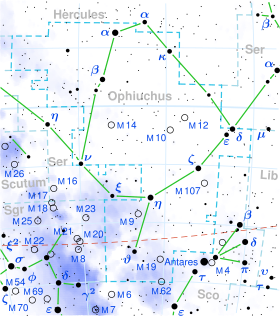24 Scorpii is a star that was originally placed by John Flamsteed within the constellation of Scorpius but in now placed within the southeastern constellation of Ophiuchus. It is visible to the naked eye as a faint, yellow-hued point of light with an apparent visual magnitude of 4.91.[2] Based on the trigonometric parallax published in Gaia Data Release 2, the star lies approximately 121 parsecs or 390 light years away.[1] It is positioned near the ecliptic and thus is subject to lunar occultations.[10]
| Observation data Epoch J2000 Equinox J2000 | |
|---|---|
| Constellation | Ophiuchus |
| Right ascension | 16h 41m 34.38407s[1] |
| Declination | −17° 44′ 31.8047″[1] |
| Apparent magnitude (V) | 4.91[2] |
| Characteristics | |
| Spectral type | G7.5IICN1Ba0.4[3] |
| U−B color index | +0.85[4] |
| B−V color index | +1.11[4] |
| Astrometry | |
| Radial velocity (Rv) | −25.20[5] km/s |
| Proper motion (μ) | RA: −21.670[1] mas/yr Dec.: −1.224[1] mas/yr |
| Parallax (π) | 8.2914 ± 0.2626 mas[1] |
| Distance | 390 ± 10 ly (121 ± 4 pc) |
| Absolute magnitude (MV) | −0.60[2] |
| Details[6] | |
| Mass | 2.51 M☉ |
| Radius | 22 R☉ |
| Luminosity | 208 L☉ |
| Surface gravity (log g) | 2.15 cgs |
| Temperature | 4,667 K |
| Metallicity [Fe/H] | −0.13[7] dex |
| Rotational velocity (v sin i) | 5.3[8] km/s |
| Age | 692 Myr |
| Other designations | |
| Database references | |
| SIMBAD | data |
This object is a luminous giant star that is classified by spectral and luminosity class as G7.5II[3] or G7.5II-IIICN1Ba0.5.[9] 24 Sco is associated with the faint reflection nebulae RfN VDB 109[9] or GN 16.36.7,[11] but may just lie along the same line of sight.[12] It is a very mild Barium star, but the enhanced barium lines in the spectrum may be a simple luminosity effect rather than a true abundance anomaly.[13] It is a probable horizontal branch star, fusing helium in its core, with just a 13% likelihood that it is still on the red giant branch.[6] The star has 2.51 times the mass of the Sun and has expanded to 22 times the Sun's radius. It is radiating 208 times the Sun's luminosity from its photosphere at an effective temperature of 4,667 K.[6]
References
edit- ^ a b c d e f Brown, A. G. A.; et al. (Gaia collaboration) (August 2018). "Gaia Data Release 2: Summary of the contents and survey properties". Astronomy & Astrophysics. 616. A1. arXiv:1804.09365. Bibcode:2018A&A...616A...1G. doi:10.1051/0004-6361/201833051. Gaia DR2 record for this source at VizieR.
- ^ a b c Anderson, E.; Francis, Ch. (2012). "XHIP: An extended hipparcos compilation". Astronomy Letters. 38 (5): 331. arXiv:1108.4971. Bibcode:2012AstL...38..331A. doi:10.1134/S1063773712050015. S2CID 119257644. Vizier catalog entry
- ^ a b Hoffleit, D.; Warren, W. H. (1995). "VizieR Online Data Catalog: Bright Star Catalogue, 5th Revised Ed. (Hoffleit+, 1991)". VizieR On-line Data Catalog: V/50. Originally Published in: 1964BS....C......0H. 5050. Bibcode:1995yCat.5050....0H.
- ^ a b Mermilliod, J. C. (2006). "VizieR Online Data Catalog: Homogeneous Means in the UBV System (Mermilliod 1991)". VizieR On-line Data Catalog: II/168. Originally Published in: Institut d'Astronomie. 2168. Bibcode:2006yCat.2168....0M.Vizier catalog entry
- ^ Wilson, R. E. (1953). "General Catalogue of Stellar Radial Velocities". Carnegie Institute Washington D.C. Publication. Carnegie Institution for Science. Bibcode:1953GCRV..C......0W. ISBN 9780598216885. LCCN 54001336.
- ^ a b c Stock, Stephan; Reffert, Sabine; Quirrenbach, Andreas (2018). "Precise radial velocities of giant stars. X. Bayesian stellar parameters and evolutionary stages for 372 giant stars from the Lick planet search". Astronomy and Astrophysics. 616: A33. arXiv:1805.04094. Bibcode:2018A&A...616A..33S. doi:10.1051/0004-6361/201833111. S2CID 119361866. Vizier catalog entry
- ^ Reffert, Sabine; Bergmann, Christoph; Quirrenbach, Andreas; Trifonov, Trifon; Künstler, Andreas (2015). "Precise radial velocities of giant stars". Astronomy & Astrophysics. 574: A116. arXiv:1412.4634. Bibcode:2015A&A...574A.116R. doi:10.1051/0004-6361/201322360. hdl:10722/215277. S2CID 59334290. Vizier catalog entry
- ^ De Medeiros, J. R.; Alves, S.; Udry, S.; Andersen, J.; Nordström, B.; Mayor, M. (2014). "A catalog of rotational and radial velocities for evolved stars". Astronomy & Astrophysics. 561: A126. arXiv:1312.3474. Bibcode:2014A&A...561A.126D. doi:10.1051/0004-6361/201220762. S2CID 54046583. Vizier catalog entry
- ^ a b c "HD 150416". SIMBAD. Centre de données astronomiques de Strasbourg. Retrieved 2014-05-11.
- ^ Richichi, A.; et al. (January 2016), "Lunar Occultations of 18 Stellar Sources from the 2.4 m Thai National Telescope", The Astronomical Journal, 151 (1): 5, Bibcode:2016AJ....151...10R, doi:10.3847/0004-6256/151/1/10, S2CID 119258140, 10
- ^ "GN 16.36.7 - Reflection Nebula". Retrieved 12 June 2019.
- ^ van den Bergh, S. (December 1966). "A study of reflection nebulae". Astronomical Journal. 71: 990–998. Bibcode:1966AJ.....71..990V. doi:10.1086/109995.
- ^ Escorza, A.; Boffin, H. M. J.; Jorissen, A.; Van Eck, S.; Siess, L.; Van Winckel, H.; Karinkuzhi, D.; Shetye, S.; Pourbaix, D. (2017). "Hertzsprung-Russell diagram and mass distribution of barium stars". Astronomy and Astrophysics. 608: A100. arXiv:1710.02029. Bibcode:2017A&A...608A.100E. doi:10.1051/0004-6361/201731832. S2CID 119428276.
